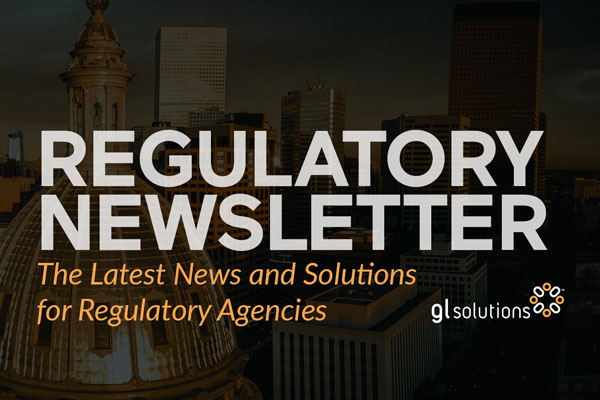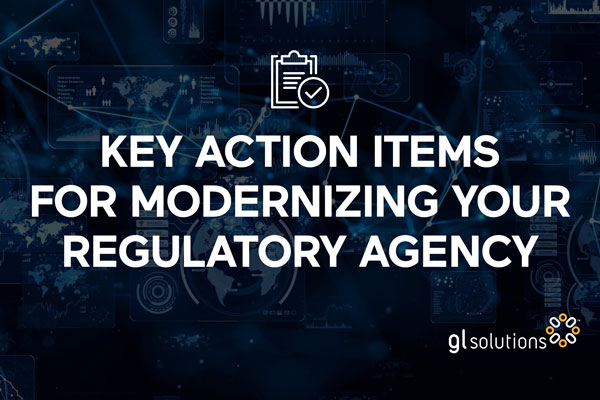Why Modernization?
COVID changed the way that government agencies operate, and the way staff worked together. Many regulatory agency staff needed to transition to remote work—and some staff members continue to work remotely now. The way we work today, with combinations of onsite, hybrid and remote working, alters the way that your staff communicate internally within the agency or the department or board. In our recent Agency Transformation webinar, we explore the why behind modernization, including the reasons to modernize your agency with a regulatory software solution —and the key steps to take.
Workflow Management
Workflow management plays an important role in the flow of work within your office, especially post-COVID. “That’s important, because with staff working from home or even in different locations, we are unable to just get out of our chair and talk to other staff members. Some of the bigger departments might have multiple locations throughout the state. So, they must be able to effectively communicate internally,” explains Sam Hardin, Vice-President of Business Solutions at GL Solutions.
Self-Service
COVID also affected the licensee population. “During COVID,” Hardin explains, “people were unable to just walk in the building and say, I’d like to pay for my renewal or I want to execute this process. The need for digital technology and online 24/7 service was brought to the forefront within the federal government, but then also the state level as well.”
Process Automation
When you bring your processes online with digital tools, you reduce your reliance on paper and manual “busy work.” Automation benefits your licensees too, giving them the ability to interact online with your regulatory agency 24/7. “No matter what, to become fully automated, is a humungous amount of change. Regulatory agencies need to follow a plan, broken down into sizable chunks to achieve that,” says Hardin. If you’re an agency using a typewriter, going to fully paperless, you can just imagine the leaps and bounds that you would have to make in the change management process to support new technologies.
Key Steps
“Most regulatory agencies have very similar modernization goals, but how they go from where they’re at to a model agency is something that’s not really discussed,” explains Hardin. Phased in modernization, or Agency Transformation offers a model that supports agencies in achieving some of these goals.
“Agency Transformation goes beyond just that one step of modernization,” explains GL Solutions’ Agency Transformation expert Michelle Shaffer. “It’s really transforming your regulatory agency and then putting you into a state of continuous improvement. And we’ve broken that down into five different phases.”
Build Capacity
Building capacity, the first phase of your Agency Transformation journey, involves understanding your state regulatory agency. “It’s your mission, your vision, your values,” explains Shaffer. “Do you know who you are and what your purpose is?”
Action items:
- Mission: Understand your agency’s mission and vision.
- Surveys: Conduct staff and licensee surveys. Ask your staff, for example, if they feel motivated by the mission and vision or your regulatory agency? Surveys help you better understand how others perceive your agency too, including the public.
- Management: Develop a management plan; a carefully constructed management plan helps to support your goals.
Standardize Processes
Process standardization, the second phase of Agency Transformation, focuses on the backend of your regulatory software application. Your government agency works on standardizing your regulatory processes. Process standardization ensures quality and consistency within your system.
“You want your employees to be effective and efficient. You also want to make sure that everyone is doing their process the same way every time. And that really lends itself to the quality of your data,” explains Shaffer.
Action items:
- Process guides: Use business process guides to lead employees step-by-step through business processes, ensuring they perform their work accurately, efficiently and consistently. “Process guides help cut down on training time,” says Shaffer. The guides walks them through the business process, even tracking the work performed so far.
- Ad-hoc reports: Create reports on the fly, as needed. Ad hoc reports enable you to query any information in the system to create reports for FOIA requests and more.
Serve Customers
Customer service, the third phase on the Agency Transformation journey, means taking a “web-first mentality,” explains Shaffer. For self-service licensing, she says, you “put anything and everything you can think of online.” Post COVID, people expect to go online—to apply or renew a license and to file a complaint. By serving your customers online, you also get closer to the goal of a paperless system.
Action items:
- Single sign-on (SSO): Use a third-party credential management system, like Microsoft, Facebook or Google, for logging in. “Using SSO,” explains Hardin “takes the burden off your agency from getting those phone calls, and questions from your licensee population when they forgot their password.”
- Licensee dashboard: Enable your licensees to manage the information they provide to your regulatory agency with their own dashboard—from printing licenses to making payments.
Integrate Services
The fourth phase of Agency Transformation, Integrated Services, means integrating your business processes and online services into a holistic system. With this step, your regulatory agency enjoys “seamless workflows, faster processing and efficient employees,” says Shaffer. “It’s all about communication management,” she explains, “whether with internal staff, back and forth to the public, with your licensee population, or with those that you’re permitting.”
Action items:
- QR codes: Add QR codes to printed licenses, helping to add another level of ease and security in your digital infrastructure.
- Virtual wallet card: Give licensees a virtual wallet card for their license. With people keeping everything on their phones, this mobile wallet card makes things easy for your licensees.
- Staff/supervisor dashboards: Use dashboards to support your staff in viewing their current workload. And use dashboards to help your supervisors view and manage the workload of their staff. Shaffer explains that this feature helps to “balance the workloads” of your staff. A supervisor’s view, for example, reveals the employees with a heavier or lighter load.
Model Agency
The final phase, the Model Agency phase of Agency Transformation, puts your regulatory agency in the position to serve as a model agency for other agencies. “A model agency really looks towards continuous improvement,” explains Shaffer. “It’s really analyzing your business processes. It’s analyzing your staff performance, seeing where the bottlenecks are. How long does it take for us to turn around the license? How long does it take to move through a case? Where are things getting hung up? Where can we put additional measures to help improve these processes. And so, we really want to be able to measure that success.”
Action items:
- Power BI reports: Use Microsoft Power Business Intelligence reporting to harness your metrics and display them in a visually captivating way to easily communicate your metrics. According to Shaffer, “these reports can be tailored to show what you want to see—which data analytics are important to you and what’s going to drive those business decisions.” And the visuals make the information easier to digest, explains Hardin. “Especially if you’re presenting to a board or a legislative committee that maybe is not super familiar with the data that you’re collecting, it’s a much simpler way to present these types of reports to them, rather than just numbers.”
- Continuous Improvement: Improving continuously also means staying on top of any legislative changes. “Legislative changes come whether we want them to or not,” says Shaffer. We want to be in a position where we’re proactive—to make those adjustments as necessary—instead of being reactive to those changes.”
Next Steps
Evaluate
Decide where your agency lands on the modernization journey. What phase sounds most like your agency? Perhaps you still struggle with paper? Or maybe you feel ready to serve customers online. Wherever you fall, pick up those next steps to move towards a model agency with digital transformation. Take our agency modernization quiz to help you decide.
Learn
Watch our Agency Transformation webinar to learn more about GL Solutions’ Agency Transformation Service—our process and best practices to guide you step-by-step through the modernization and transformation journey.
Partner
Contact GL Solutions if you need a partner to help you proceed down the agency transformation path towards a sustainable future. As Hardin explains, GL Solutions provides analysis to pinpoint the phase your agency is in right now. “We can actually give you an action plan and a roadmap for how to get to that phase 5, model agency,” he says.
Time to Modernize
GL Solutions helps your regulatory agency run, grow and adapt through modern software and automation that helps solve your agency’s greatest challenges. To learn more, contact us.
To receive the latest regulatory news delivered to your inbox each week, subscribe to our newsletter.


